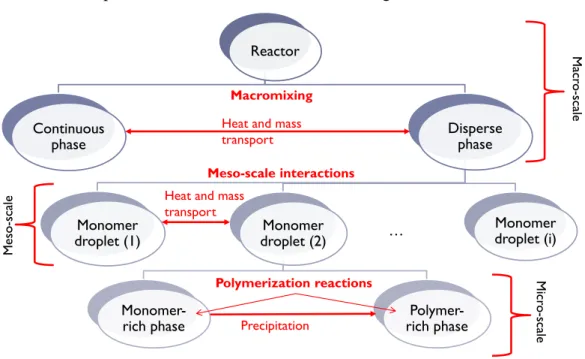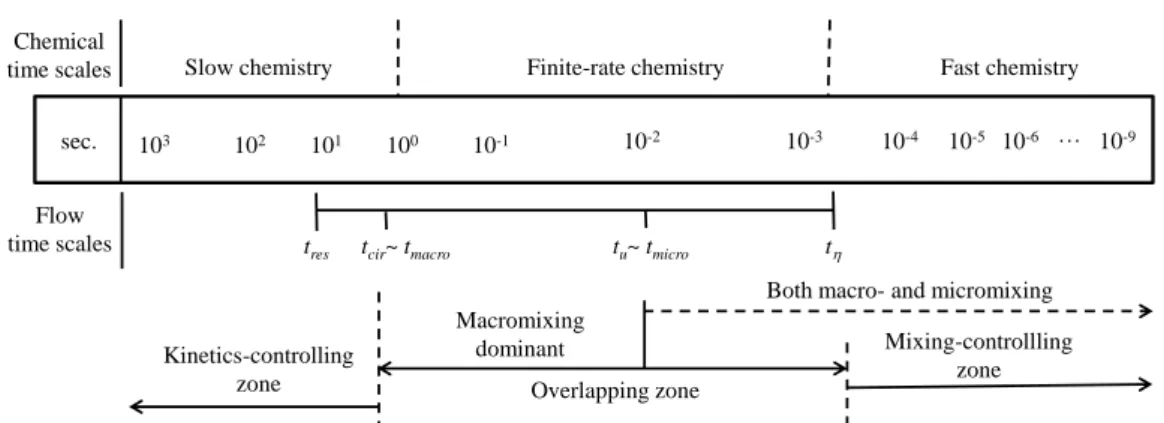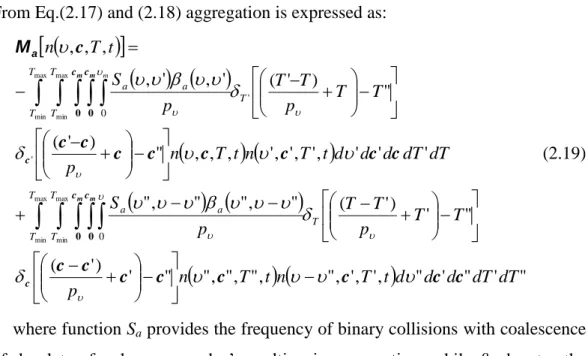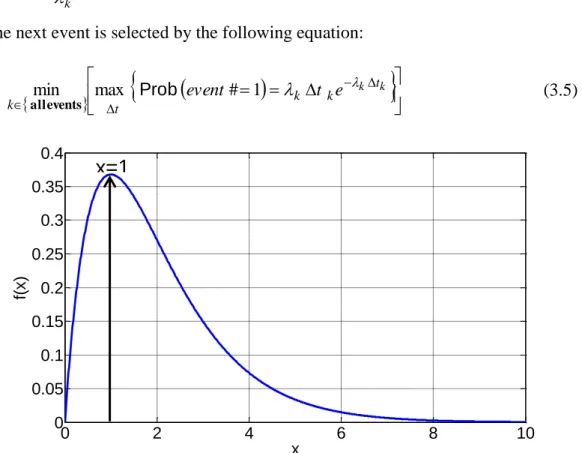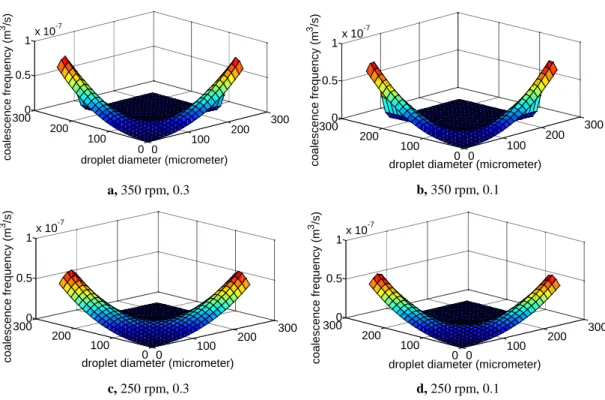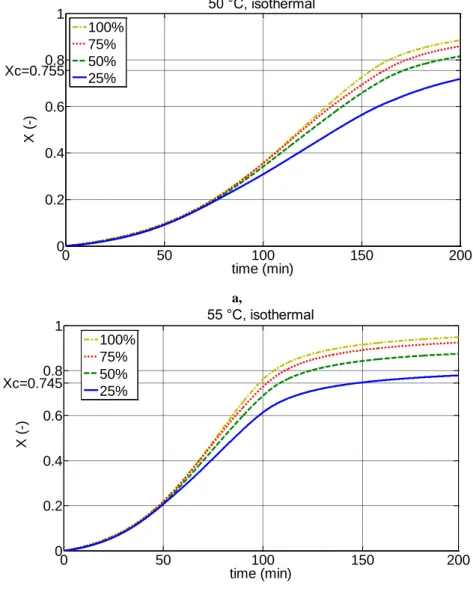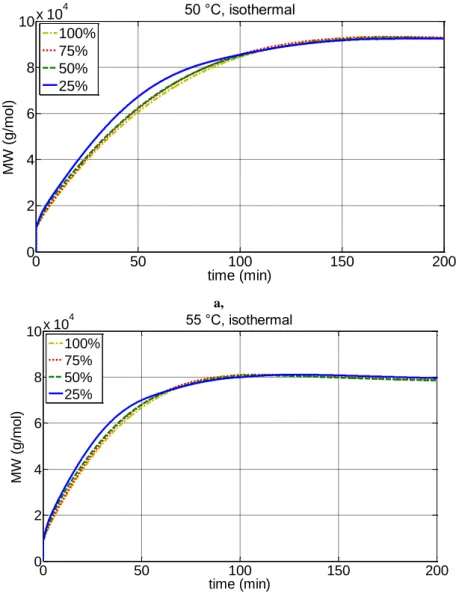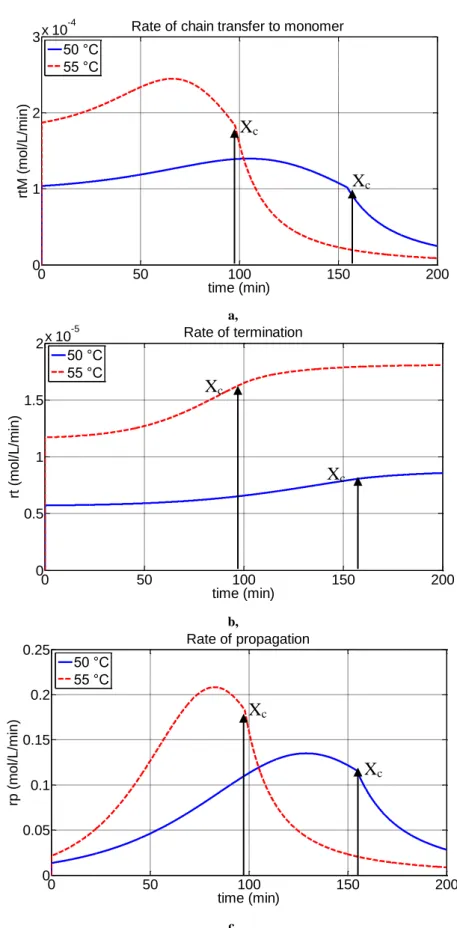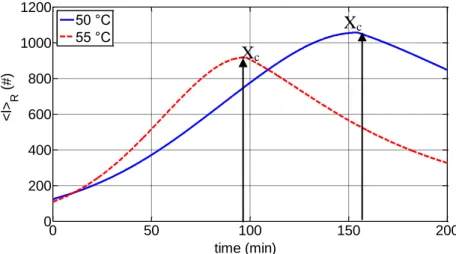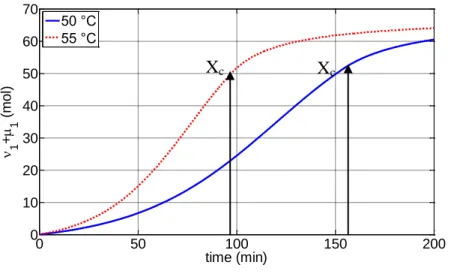DOKTORI (PhD) ÉRTEKEZÉS
BÁRKÁNYI ÁGNES
Pannon Egyetem 2014
DOI: 10.18136/PE.2014.530
Hidrodinamikai viszonyok hatásának vizsgálata polimerizációs reaktorok termékminőségére
DOKTORI (PhD) ÉRTEKEZÉS Bárkányi Ágnes
Konzulensek
Dr. Lakatos Béla, egyetemi docens Dr. Németh Sándor, egyetemi docens
Vegyészmérnöki- és Anyagtudományok Doktori Iskola Pannon Egyetem
2014
Értekezés doktori (PhD) fokozat elnyerése érdekében
a Pannon Egyetem Vegyészmérnöki- és Anyagtudományok Doktori Iskola Doktori Iskolájához tartozóan*.
Írta:
Bárkányi Ágnes
Konzulensek: Dr. Lakatos Béla
Elfogadásra javaslom igen / nem ……….
(aláírás) Dr. Németh Sándor
Elfogadásra javaslom igen / nem ……….
(aláírás) A jelölt a doktori szigorlaton ...%-ot ért el,
Az értekezést bírálóként elfogadásra javaslom:
Bíráló neve: …... igen /nem
……….
(aláírás) Bíráló neve: …... igen /nem
……….
(aláírás) A jelölt az értekezés nyilvános vitáján …...%-ot ért el.
Veszprém, ……….
a Bíráló Bizottság elnöke A doktori (PhD) oklevél minősítése…...
………
Az EDHT elnöke
Analysis of hydrodynamic effects on product quality in polymerization reactors
PhD Thesis
Ágnes Bárkányi
Supervisors Béla Lakatos, CSc Sándor Németh, PhD
Doctoral School in Chemical Engineering and Material Science University of Pannonia
2014
Kivonat
Hidrodinamikai viszonyok hatásának vizsgálata polimerizációs reaktorok termékminőségére
A dolgozat diszperz rendszerekben lejátszódó folyamatok matematikai modellezésével és vizsgálatával foglalkozik. Az olyan rendszerek, amelyekben a diszperz elemekben kémiai reakció játszódik le nagyon érzékenyek a mikro-szintű folyamatokra. Ilyen folyamat a diszperz elemek ütközése, amelynek során komponens és hőátadás megy végbe az elemek között, az elemek szétesése, vagy törése, és az elemek koaleszcenciája.
A kutatási munka első feladata egy olyan részletességű matematikai modell kidolgozása volt, amely alkalmas az összetett és sok elemből álló rendszerekben a mikro- és makro-szintű folyamatok leírására. Az ilyen típusú rendszerek vizsgálatára jól alkalmazható a populáció mérleg modell. Az elsődleges cél vinil- klorid szuszpenziós polimerizációjának vizsgálata volt szakaszos, kevert reak- torban. Ebben a rendszerben a diszperz elemek a monomer cseppek, amelyekben bonyolult polimerizációs reakciók mennek végbe. Mivel ezek a reakciók erősen exotermek, ezért a reakcióban a cseppeknek nem csak a térfogata és a bennük lévő egyes komponensek koncentrációja, de a hőmérséklete is jelentősen változik. Ezt a modellezési feladatot egy több-dimenziós populáció mérleg egyenlet felírásával oldhatjuk meg. A modell tartalmazza az időben folytonos események (pl. a kémiai reakció), valamint a diszperz elemeknek az időben diszkrét, véletlenszerű változásaiból (pl. ütközésekből) adódó tulajdonságváltozásait. A dolgozat második részében egy megoldási módszert mutatok be, amely alkalmas a kidol- gozott több-dimenziós populáció mérlegegyenlet megoldására. Kidolgoztam egy esemény vezérelt Monte Carlo módszert, amivel meghatározható a diszperz elemekben a folytonos idejű reakciókban történő megváltozásokat és ezzel párhuzamosan a diszkrét események miatt bekövetkező megváltozásokat.
Mivel az iparban a reaktorokat nagyrészt folyamatos üzemmódban üzemeltetik, ezért fontos, hogy a kifejlesztett szimulációs technika erre a típusra is alkalmas legyen. A dolgozat harmadik része a mikrokeveredés hatásának vizsgálatát mutatja be folyamatos üzemű, egyfázisú reaktor példáján keresztül. Szimulációs vizsgálatokkal szemléltethető, hogy milyen hatása van a reagens koncentráció térbeli eloszlásának, ha a komponensek elkeveredése nem tökéletes az egyes fluidum elemek között.
Abstract
Analysis of hydrodynamic effects on product quality in polymerization reactors
The main subject of this thesis is the modelling and simulation of suspension polymerization of vinyl chloride. A multi-dimensional population balance equation was developed for modelling the disperse system and the micro- and meso-scale processes. Two parallel processes are taking place inside the reactor:
polymerization reactions inside the dispersed phase, continuous in time, and the meso-scale interactions of dispersed elements, discrete in time. A coupled continuous time – Monte Carlo method was developed for solution of the multi- dimensional population balance equation. The effects of inhomogeneities of initiator distribution, the initial size distribution of monomer droplets and the effects of temperature rise in droplets on polymer properties and monomer conversion were analysed by simulation studies.
Since in industry most of the reactors are operated in a continuous manner, therefore in the thesis there is a case study for the analysis of the effects of micromixing in a continuous reactor. The developed coupled continuous time – Monte Carlo method was improved for solution of the continuous case.
Auszug
Die Untersuchung der hydrodynamischen Effekte auf die Produkt Qualität in den Polymerisation Reaktoren
Das Hauptziel der Dissertation ist die Modellierung und das Simulation der Suspension Polymerisation des Vinylchlorids. Eine multi-dimensionale Population Bilanz Gleichung wurde für die Modellierung des dispersen Systems und der Micro- und Meso-Skala Prozesse ausgebildet. Zwei parallele Prozesse verlaufen im Reaktor: die Polymerisation Reaktionen in der dispersen Phase, die sind kontinuierlich in der Zeit, und die Meso-Level Wechselwirkungen der dispersen Elemente, die sind diskret in der Zeit. Eine gekuppelte kontinuierliche Zeit – Monte Carlo Methode wurde für die Lösung der multi-dimensionalen Population Bilanz Gleichung ausgebildet. Der Effekt der Inhomogenität der Initiator Verteilung, der einleitenden Monomer Tropfen Verteilung und der Temperaturerhöhung in den Tropfen auf die Polymer Qualität und der Monomer Konversion wurden durch Simulationen analysiert.
In der Industrie funktionieren die meisten Reaktoren kontinuierlich, deshalb gibt es ein Beispiel für die Analyse des Effekts des Micro-Mischens in einem kontinuierlich funktionierenden Reaktor. Die ausgebildete gekuppelte kontinuierliche Zeit – Monte Carlo Methode wurde für die Lösung der kontinuierlichen Fälle verändert.
Contents
Notations ... i
Introduction ... 1
1. Literature survey ... 2
1.1. Polymerization ... 2
1.1.1. Suspension polymerization ... 6
1.2. Modelling of batch suspension polymerization reactors ... 13
1.2.1. Micro-scale modelling ... 14
1.2.2. Meso-scale modelling ... 18
1.2.3 Macro-scale modelling ... 25
1.3. Modelling of micromixing in turbulent, non-isothermal continuous stirred reactors ... 28
1.4. Solution of the multi variable population balance equation ... 32
2. The detailed population balance model for suspension polymerization 39 2.1. The general population balance equation ... 39
2.2. Birth and Death functions ... 43
2.2.1. Breakage processes ... 43
2.2.2. Aggregation processes ... 45
2.2.3. Coalescence/redispersion processes ... 47
2.3. Meso-scale model of the droplet population ... 50
3. Solution of the multi-variable population balance equation. A coupled continuous time – Monte Carlo method... 54
3.1. A coupled continuous time-Monte Carlo method ... 54
3.2. Selection of the minimal population size for simulation ... 59
3.3. Application of the coupled continuous time – Monte Carlo method for the simulation of suspension polymerization of vinyl chloride ... 62
3.3.1. The simulation results... 69
4. Application of Monte Carlo method for the calculation of micromixing in turbulent, non-isothermal continuous stirred reactor ... 93
4.1 The analysed system and model equations ... 94
4.2. The applied Monte Carlo method ... 96
4.3. The simulation results ... 99
4.3.1 Algorithm verification ... 99
4.3.2 Influence of micromixing ... 102
5. Summary and Theses ... 110
5.1. Tézisek ... 111
5.2. Theses ... 113
5.3 Publications related to theses ... 116
List of Figures ... 120
References ... 124
i
Notations
A heat transfer surface area of the reactor [m2] (in Section 1 and 3.);
pre-exponential factor (in Section 4.)
a parameter in Eq.(1.25,26); heat transfer surface area [m2] B birth density function (in Section 2.)
B(a,b) beta function with parameters a and b
b parameter
C parameter CI,II,IV constants
c parameter
c vector of concentrations
cI concentration of initiator in a droplet [mol/ m3] cM concentration of monomer in a droplet [mol/ m3] cp heat capacity [J/gK]
D impeller diameter [m] (in Section 1.); death density function (in Section 2.)
d diameter [m]
Ea activation energy Ef the next reaction
f chemical or intrinsic initiator efficiency h heat transfer coefficient [W/m2K]
h(d,d’) collision intensity of drops of volume v and v’ [m3/s]
I initiator
I* active initiator radical
0,1
xI indicator function of beta distribution K number of components
k thermal conductivity [W/mK] (in Section 1 and 3); rate constant of a chemical reaction (in Section 4.)
kd initiator decomposition rate coefficient [1/s]
kI initiation rate coefficient of initiator [m3/(mol∙s)]
kp propagation rate coefficient [m3/(mol∙s)]
ii kt rate coefficient of termination [m3/(mol∙s)]
ktc rate coefficient of termination by combination [m3/(mol∙s)]
ktd rate coefficient of termination by disproportion [m3/(mol∙s)]
ktM chain transfer to monomer rate coefficient [m3/(mol∙s)]
N impeller speed [rpm] (in Section 1.); Poisson process counting events (in Section 2.); number of droplets [#] (in Section 3.)
) (1
N total number of droplets present in some finite subregion of disperse phase space ξ1
Nu Nusselt number )
,
( t
n number density function over a region ξ nM0 initial value of monomer [mol]
M monomer
Ma operation of the aggregation event Mb operation of the breakage event
dd
Mc/r operation of coalescence/redispersion event
n(c,T,t)
MiK generalized coalescence/redispersion model of micromixing Mw molecular weight of monomer [g/mol]
MN number average molecular weight [g/mol]
MW weight average molecular weight [g/mol]
m mass [g]
Pi the closed polymer chain with chain length i PDI polydispersity index
Pr Prandtl number
Q liquid volumetric flowrate [m3/s]
reaction
Q nascent heat due to polymerization reactions [J/s]
d trans
Q _ heat transfer from dispersed phase to the continuous phase [J/s]
j trans
Q _ heat transfer to the cooling jacket from continuous phase [J/s]
q flow rate [m3/s]
R universal gas constant [J/molK]
R(Es) the probability that reaction Es occurs
Ri the growing polymer chain with chain length i
iii Re Reynolds number
r1,2 random numbers
Sa frequency of binary collisions with coalescence [m3/s]
Sb breakage rate of droplets of state (υ,c,T) [1/s]
dd
Scol frequency of binary collisions without coalescence [m3/s]
T temperature [K]
t time [s]
U overall heat transfer coefficient [W/m2K]
u average velocity of droplet [m/s]
Vc volume of continuous phase [m3] v velocity of droplet in region R ve external droplet velocity vi internal droplet velocity X monomer conversion [-]
Xc critical conversion [-]
x vector coordinates of region R
Greek symbols
α constant
βa resulting volume of such an event aggregation
βb(d,d’) probability density function for droplets from the breakup of droplets of state (d) at time that have state (d’)
"
diffusive component transfer coefficient ΔHr heat of polymerization [J/mol]
Δtk denote the next event time [s]
δ Dirac delta function ρ density [g/cm3]
ρd density of dispersed phase [g/cm3]
ε energy dissipation rate [m2/s3] (in Section 1); volume fraction of the continuous phase (in Section 2)
Θ contact time [s]
λ(d,d’) coalescence efficiency
iv λk intensity, mean frequency of k event
c viscosity of continuous phase [poise]
µj jth moment of dead polymer chains
j jth moment of live polymer chains
(υ’,c’,T’,t) average number of droplets formed from the breakup of a single droplet of state (υ’,c’,T’) at time t
interfacial tension [dyn/cm]
τmicro the next event time [s]
υ volume of droplet [m3]
disperse phase volume fraction [-]
ω random number
Subscripts
1 monomer rich phase 2 polymer rich phase c continuous phase d dispersed phase
j cooling jacket of the reactor
m monomer
p polymer
v vessel
w wall of the reactor
1
Introduction
The macromolecular architecture (e.g. molar mass, molecular weight distribution (MWD), copolymer composition distribution (CCD), chain sequence length distribution (CSLD), branching distribution (BD), stereoregularity, etc.) depends not only on the chemical nature of the monomers, the type of polymerization mechanism and the physical state of the reacting system (e.g.
polymerization process) but also on the type of reactor configuration. It should be emphasized that product quality is a much more complex issue in polymerization processes than in conventional short chain reactions since the molecular and morphological properties of a polymer product strongly influence its physical, chemical, thermal, rheological, mechanical properties as well as the polymer's end-use applications. Therefore, the development of comprehensive mathematical models to predict the polymer quality in terms of process operating conditions in a polymer reactor is the key to the efficient production of high quality, tailored polymer products and the improvement of plant operability and economics.
To discover, recognize the relationship between the properties of the product and the reaction conditions, rigorous mathematical models are needed, which can describe the properties of various phases in reactor, the relationship between the phases, together with the hydrodynamic effects.
The aim of this work is to develop such a mathematical model, which can describe the phenomena in liquid-liquid dispersions together with complex reactions inside the dispersed phase. The solution of such complex multi- dimensional mathematical model equations seems to be a crucial problem.
Therefore, the other aim of this work is to develop a robust; easy to implement method which is appropriate to simulate the phenomena in liquid-liquid dispersions, such as suspension polymerization of vinyl chloride.
Since in industry the most of reactors are operated continuously, therefore, in the thesis there is an example for the analysis of the effect of micromixing in a continuous reactor.
2
1. Literature survey
In this section, the most important classification of polymers and polymeriza- tion processes is introduced. The process of suspension polymerization and the suspension polymerization of vinyl chloride is described in detail. After that, the scales of the modelling of polymerization reactors and the most important methods of solution of the model equations are introduced.
1.1. Polymerization
Polymers are macromolecules built up by the linking together of large numbers (e.g. hundreds, thousands even tens of thousands) of much smaller molecules, called monomers. The reactions by which monomers combine are termed polymerizations. Polymer materials can be classified according to one or more of the following criteria:
Chemical nature of monomers.
Molecular structure of polymers.
Polymer chain growth mechanism.
Type of polymerization process.
Notice that the above criteria are not unique and several other alternative classifications have been proposed in the literature (Ram, 1997).
Classification by the molecular structure of polymers
a) According to the number of different structural units present in a polymer chain, polymers can be classified into:
Homopolymers which are built by the linking together of a large number of a single repeating unit.
Copolymers formed from more than one type of monomers. They are called bipolymers, terpolymers, multipolymers according to the number of different structural units in a polymer chain.
b) Another common classification of polymers is according to the polymer chain structure. Thus, polymers can be
linear,
3
branched,
comb-like,
star-like,
cyclic,
dendrimer polymers.
c) Polymer molecules can be further classified according to their degree of stereoisomerism (e.g. the relative arrangements of configuration units in a chain). Stereoisomerism in polymers can be:
Optical isomerism arises from different configurations of substituents on a saturated carbon atom.
Geometrical isomerism arises from different configurations of substituents on a carbon-carbon double bond or on a cyclic structure.
Classification by the kinetic mechanism
Step-growth polymerization refers to a type of polymerization mechanism in which bi-functional or multifunctional monomers react to form first dimers, then trimers, longer oligomers and eventually long chain polymers.
Free-radical polymerization is a method of polymerization by which a polymer forms by the successive addition of free radical building blocks. All free-radical polymerizations have at least three basic reaction types occurring simultaneously during polymerization. These include initiation reactions which continuously generate radicals during the polymerization, propagation reactions which are responsible for the growth of polymer chains by monomer addition to a radical centre and bimolecular termination reactions between two radical centres which give a net consumption of radicals.
Anionic polymerization can be initiated by bases or Lewis bases such as alkali metals, alkoxides, amines, phosphines, Grignard compounds and sodium naphthaline. Polymerization is carried out at low temperatures in solvents of low polarity giving tightly bound ion pairs rather than mainly separate ions.
4
Cationic polymerization is a type of chain growth polymerization in which a cationic initiator transfers charge to a monomer which becomes reactive. This reactive monomer goes on to react similarly with other monomers to form a polymer.
Group transfer polymerization is a relatively new type of mechanism relies on a silicon-based initiator, most commonly a silyl ketene acetal.
The initiator is un-reactive with respect to monomer except in the presence of a catalyst which may be either a nucleophile or Lewis acid.
Coordination anionic polymerization is a form of addition poly- merization in which monomer adds to a growing macromolecule through an organometallic active centre. The polymers tend to be linear and not branched and have much higher molar mass than polymer prepared by free radical polymerization.
Classification of polymerization processes
Bulk polymerization is carried out by adding a soluble initiator to pure, liquid state monomer. The initiator should dissolve in the monomer.
The reaction is initiated by heating or exposing to radiation. As the reaction proceeds, the mixture becomes more viscous. The reaction is exothermic and a wide range of molecular masses are produced.
In solution polymerization a monomer is dissolved in a non-reactive solvent that contains a catalyst. The reaction results in a polymer which is also soluble in the chosen solvent. Heat released by the reaction is absorbed by the solvent, and so the reaction rate is reduced. Moreover the viscosity of the reaction mixture is reduced, not allowing auto acceleration at high monomer concentrations. Once the maximum or desired conversion is reached, excess solvent has to be removed in order to obtain the pure polymer.
Precipitation polymerization is a heterogeneous polymerization process that begins initially as a homogeneous system in the continuous phase, where the monomer and initiator are completely soluble, but upon initiation the formed polymer is insoluble and thus precipitates.
5
Suspension polymerization is a heterogeneous radical polymerization process that uses mechanical agitation to mix a monomer or mixture of monomers in a liquid phase, such as water, while the monomers polymerize, forming spheres of polymer. The polymerization reaction takes place in monomer droplets.
Emulsion polymerization is a type of radical polymerization that usually starts with an emulsion incorporating water, monomer, and surfactant. The most common type of emulsion polymerization is an oil-in-water emulsion, in which droplets of monomer (the oil) are emulsified (with surfactants) in a continuous phase of water. The excess of surfactant form micelles (ca. 5-10 µm in diameter) which are clusters of surfactant molecules.
Solid catalysed polymerization. Although some catalysts are used in liquid form, most are heterogeneous, solid catalysts which can be supported or unsupported. The monomer in contact with the catalyst could be gaseous (gas phase process), a pure liquid (liquid solution process) or dissolved in a diluent (slurry process). In all cases, the porous catalyst fractures and fragments of the catalyst are dispersed in the polymer and become the locus of polymerization.
Interfacial polymerization is an alternative to bulk polymerization of condensation polymers which would require high temperatures. Two immiscible solvents are used, with monomer in one solvent reacting with monomer in the other solvent. Reactions often occur on a time scale that so fast that for our purposes they might as well be called instantaneous. Higher molecular weights are obtained because monomer is more likely to encounter a growing chain than the opposing monomer.
Solid-state polymerization in the solid state can produce macroscopic polymer single crystals and, in some cases, crystals of high optical quality. The propagation reaction is controlled by the crystal structure and symmetry of the monomer. Thus, in certain cases the propagation reaction may lead to a crystal-to-crystal transformation.
6 1.1.1. Suspension polymerization
Suspension polymerization is used for the commercial manufacturing of many important polymers including poly(vinyl chloride), poly(methyl methacrylate), expandable polystyrene, styrene-acrylonitrile copolymers and a variety of ion exchange resins. Suspension polymerization was first developed by Hoffman and Delbruch in 1909. The first suspension polymerization based on acrylic monomers leading to the formation of beads was performed by Bauer and Lauth in 1931 (Dowding and Vincent, 2000).
In suspension polymerization, one or more water-insoluble monomers containing oil-soluble initiator(s) are dispersed in a continuous liquid phase by a combination of strong stirring and the use of small amounts of suspending agents (stabilizers). The stabilizers hinder the coalescence of the monomer droplets first, and later stabilize the polymer beads whose tendency to agglomerate may become critical when the polymerization has advanced to the point where the polymer beads become sticky (Yuan et al., 1991).
Monomer solubility in the continuous phase is often low and polymer is produced inside the drops. Although the drop viscosity increases with monomer conversion, the effective viscosity of the suspension remains low and efficient agitation is possible. The ratio of surface area to volume for small drops is relatively high and local heat transfer is good. If the continuous phase is aqueous and well mixed, heat transfer from the reactor is also good. That permits effective control of temperature and of those variables, which depend on temperature, and which include reaction rates and polymer molecular weight (Meyer and Keurentjes, 2005).
There are three different types of suspension polymerization processes.
a. Bead (or Pearl) Suspension Polymerization. The monomer dissolves its polymer. The monomer droplets pass through a viscous syrupy state and finally are transformed to solid clear little spheres. Examples of this process are poly(methyl methacrylate) and polystyrene.
b. Powder Suspension Polymerization. The polymer is not dissolved in its monomer. A bulk precipitation polymerization occurs in each droplet, and
7 opaque, irregular grains or powders are finally formed. An example of this type is PVC.
c. Mass Suspension Polymerization. This is a two stage process. In the first stage a rubber is dissolved in the grafting liquid monomer mixture. The mixture is polymerized initially in a bulk process. When the conversion reaches 25-30%, the highly viscous reaction mass is transferred to a suspension reactor filled with water containing stabilizer. The reaction proceeds until the desired monomer conversion is reached. An example of this process is the production of high impact polystyrene and acrylonitrile-butadiene-styrene resin (Yuan et al, 1991).
The most important issue in the practical operation of suspension poly- merization is the control of the final particle size distribution. Suspension polymer particle diameters range is usually between 50 and 200 μm, the exact size depending on the monomer type, the concentration of stabilizers, and the agitation conditions in the reactor (Yuan et al, 1991).
The physical conditions in a suspension polymerization reactor affect the drop size distribution significantly. Drop size depends on the physical properties of the two phases, the phase ratio, the nature of the suspension flow, and the condition of the phase interface. Drop breakage in agitated suspensions can be caused either by frictional forces (through viscous shear) or by inertial forces (through turbulence) (Brooks, 2010). In industrial suspension polymerization, the volume fraction of the dispersed phase is usually high and drop breakup is accompanied by drop coalescence. Thus, both the average drop size and the drop size distribution are influenced by drop breakage and drop coalescence.
Interfacial tension and drop stability depend largely on the nature of the drop stabilizer. If no stabilizer were used to protect the drops, the suspension would be unstable and the final polymer particles would reach an undesirable size. The adsorption of stabilizer molecules at the interface between monomer and the continuous phase reduces the interfacial tension and hence reduces the energy required to form drops. Drop stability against coalescence depends largely on the ability of the stabilizer to form a thin protective film at the interface. That gives the drops better elastic properties (Rosen, 2004). The effect of the elastic
8 properties is enhanced by increasing the concentration of the suspending agent, until a certain surface coverage of the drops is reached. At that point, a „„critical surface coverage‟‟ is established and a further increase in the suspending agent concentration will have a very little effect on the drop stability (Borwankar and Wasan, 1986).
1.1.1.1 Suspension polymerization of vinyl chloride
PVC is one of the most important mass products of the polymer industry, it is the third most widely produced plastic after polyethylene and polypropylene. PVC is widely used in construction because it is durable, cheap, and easily worked.
Approximately 75% of the world‟s PVC is produced by the suspension poly- merization process (Kiparissides et al, 1997). Advantages of suspension poly- merization are not restricted to temperature control. In this technique, the dispersion viscosity is low, the levels of impurities in the polymer product is low, therefore the separation cost is low and the final product is in particle form. PVC is immiscible with vinyl chloride. Subsequent polymer coagulation makes bulk processes difficult to control. In suspension polymerization, however, that problem is avoided. There, coagulation is largely confined to the drop interiors and aggregation of polymerizing drops is restricted. That is why suspension polymerization is used for the large-scale production of PVC. In that case, the initial drop diameters, and the final particle sizes, range between 10 and 100 mm.
Although PVC is produced in high volume it is produced in batch reactors the present tendency being of working in reactor so large volume (160-200 m3).
In suspension polymerization of VCM, the droplets of liquid vinyl chloride monomer (VCM) containing oil-soluble initiator(s) are dispersed in the continuous aqueous phase by a combination of strong stirring and the use of suspending agents (stabilizers) (Kiparissides et al, 1997). The most commonly used suspending agents for vinyl chloride suspension polymerization are water- soluble polymers such as hydroxylpropyl methylcellulose (HPMC) and partially hydrolysed polyvinyl acetate, commonly called PVA (Saeki and Emura, 2002).
When partially hydrolyzed polyvinyl acetate (PVA) is used as a stabilizer, its behaviour depends on the extent to which the acetate groups are hydrolyzed (Atanase and Riess, 2010). Good drop stabilization can be achieved in aqueous
9 media when the degree of hydrolysis (DH) is between 70 and 80 %; then, drops can retain their integrity even when agitation levels are reduced (Zerfa and Brooks, 1996a,b). PVAs with a DH less than 60 % are poor drop stabilizers in aqueous media but they can affect polymer morphology inside the (nonaqueous) drops. That is important in the suspension polymerization of vinyl chloride (VC).
In that case, small particles of poly(vinyl chloride) (PVC) precipitate inside the monomer drops. Therefore, a mixture of two stabilizers is often used: a primary stabilizer which protects the drops from coalescence and a secondary stabilizer which affects the behaviour of the PVC particles inside the drops and increases polymer porosity. The addition of a secondary stabilizer can also affect the particle size distribution of the polymer particles (Brooks, 2010). PVC porosity can also be increased by using non-ionic surfactants as secondary stabilizers. PVA can become grafted onto the polymer formed inside the drops, so that a skin forms on the final particle surface. Formation of that skin, which is difficult to remove, can affect the final polymer properties (Zerfa and Brooks, 1996a; Zerfa and Brooks, 1996b; Zerfa and Brooks, 1998).
In suspension polymerization of VCM, each monomer droplet contains a large number of live radicals (108) and behaves like a small batch reactor with bulk polymerization kinetics (Zhang and Ray, 1997). There are many works which describe the kinetic mechanism of free radical polymerization of vinyl chloride (Sidiropoulou and Kiparissides, 1990; Kalfas and Ray, 1993; Xie et al, 1991b; De Roo et al, 2005):
Initiation:I kd 2I
Chain initiation:IM kI R1
Propagation:R1M kp R2 … RiMkp Ri1
Chain transfer to monomer:R1Mk tM R1P1 … Ri Mk tM R1Pi Termination reactions:
Spontaneous: Ri kt Pi
Combination: Ri Rj ktc Pij
Disproportionation: Ri Rj ktd Pi Pj
10 Transfer to monomer and polymer reactions are very important in VC polymerization since their frequency relative to the chain propagation reaction controls the molecular weight. Transfer to monomer causes a shift of the molecular weight distribution (MWD) to lower values. On the other hand, transfer to polymer can lead to the formation of branched polymers which causes a shift of the MWD to higher values. Transfer to monomer and intra-molecular reactions are considered to be responsible for the formation of the short side chains observed in PVC. Note that transfer reactions do not change the total number of
live polymer chains and, therefore, the rate of polymerization and the number- average molecular weight will not be affected (Sidiropoulou and Kiparissides, 1990).
VCM is usually polymerized in a batch tank reactor by dispersing the liquid monomer under pressure in water in a well stirred jacketed reactor. The reactor‟s contents are heated to the required temperature where the initiator(s) start(s) to decompose and polymerization begins. The polymerization temperature is usually over the range 50 °C – 75 °C (Smallwood, 1986). The heat of polymerization is transferred from the monomer droplets to the aqueous phase and then to the reactor wall, which is cooled by chilled water flowing through the reactor‟s jacket.
When all the free liquid monomer has been used up, the pressure in the reactor starts to fall as a result of the monomer mass transfer from the vapour phase to the polymer phase due to the sub-saturation conditions. In industrial PVC production, the reaction is usually stopped when a certain pressure drop has been recorded.
Since PVC is effectively insoluble in its own monomer once the polymer chains are first generated they precipitate immediately to form two separate phases in the polymerizing droplet. From a kinetic point of view the polymerization of VCM is considered to take place in three stages (Kiparissides et al, 1997).
During the first stage, primary radicals formed by the thermal fragmentation of initiator rapidly react with monomer molecules to produce PVC macromolecules which are insoluble in the monomer phase. The reaction mixture consists mainly of pure monomer since the polymer concentration is less than its solubility limit (conversion <0.1%).
11 The second stage extends from the time of appearance of the separate polymer phase to a critical conversion Xc at which the separate monomer phase disappears.
The reaction mixture consists of four phases, namely the monomer-rich phase, the polymer rich phase, the aqueous phase, and the vapour phase. The reaction takes place in the monomer and polymer phases at different rates and is accompanied by transfer of monomer from the monomer phase to the polymer phase so that the latter is kept saturated with monomer. The disappearance of the monomer phase is associated with a pressure drop in the reactor.
Finally, at higher conversions (Xc<X<1.0) only the polymer-rich phase swollen with monomer exists. The monomer mass fraction in the polymer phase decreases as the total monomer conversion approaches a final limiting value.
From the point of view of the morphology of PVC grains the following five- stage kinetic-physical mechanism have been postulated to describe the nucleation, stabilization, growth and aggregation of PVC primary particles (Xie et al, 1991a,b; Kiparissides et al, 1997; Yuan et al, 1991).
During the first polymerization stage (VCM conversion range: 0<X<0.01%), primary radicals, formed via thermal decomposition of initiator molecules, rapidly react with monomer to produce polymer chains that almost instantaneously become insoluble in the monomer phase. In fact, the polymer chains precipitate out of the continuous VCM phase when they reach a specific chain length (i.e., of about 10–30 monomer units). It has been postulated that approximately 10–50 polymer chains are subsequently combined together to form nano-domains also called basic particles. The nano-domains are swollen with monomer and have an initial diameter of about 10–20 nm.
In stage two (VCM conversion range: 0.01<X<1%), the formation of PVC domains, also called primary particle nuclei, takes place. Because of the limited stability of the domains they rapidly undergo coagulation leading to the nucleation of the primary particle nuclei. The initial size of these primary particle nuclei has been found to be in the range of 80–100 nm. Typically, a primary particle nucleus may consist of about 1000 nano-domains. Contrary to nano-domains, the primary particle nuclei carry sufficient negative electrostatic charges to form stable colloidal dispersions in the monomer phase. During this stage, the primary
12 particles grow in size mostly by coagulation with smaller nano-domains rather than by polymerization of the absorbed monomer.
In stage three (VCM conversion range: 1<X<20%), growth and aggregation of the primary particles occur. Primary particle nuclei are continuously produced up to a monomer conversion of about 5–10%. During this stage, the primary particles grow in size by the capture of unstable nano-domains and the polymerization of the absorbed monomer. The latter growth process is progressively becoming the dominant mechanism as the volume of the polymer phase increases. The size and the number of the primary particles depend on the growth rate and the electrostatic-steric stability of the primary particles. At monomer conversions of about 7–20%, massive aggregation of the primary particles results in the formation of a continuous three-dimensional primary particle network within the VCM droplet. The three-dimensional primary particle network structure, its initial porosity, and its mechanical strength will depend on the size and the number of primary particles, the electrostatic and steric forces between the primary particles, the polymerization temperature and the polymer viscoelastic properties.
In stage four (VCM conversion range: 20<X<70–75%), the growth and fusion of the primary particles continues. That is, the primary particles increase in size due to polymerization and also undergo substantial fusion. Both processes result in a continuous decrease in particle porosity. At low monomer conversions (i.e., in the so-called “sticky” stage, X<30%), the polymerizing droplets can undergo limited coalescence leading to the formation of multi-cellular grains. At higher monomer conversions, the droplets/particles become less “sticky” and the coalescence rate decreases significantly. On the other hand, inside the polymerizing monomer droplets, the primary particles continue to grow until the disappearance of the separate monomer phase (i.e., at about 70–75% monomer conversion).
Finally, in stage five (VCM conversion range: 70–75<X<90–95%), polymerization continues only in the monomer swollen polymer phase, however, at a lower rate, until the monomer has been depleted. During this stage, the vapour pressure in the reactor continuously decreases due to the transfer of VCM from the overhead gas phase to the monomer starved polymer phase. Note that the
13 polymerization is usually terminated at a monomer conversion of about 95–98%.
At the final VC conversion, the size of the individual primary particles is in the range of 1–1.5 µm while the size of the primary particle aggregates is about 3–10 µm. It is important to point out that the two key parameters that determine the porosity of PVC grains are: the critical monomer conversion, Xc, at which a three- dimensional primary particle network is formed and the extent of particle network contraction due to the fusion of the primary particles. The structure and strength of the primary particle network will be affected by the size, the total number and the interaction forces between the primary particles that are, in turn, influenced by the polymerization conditions (i.e. polymerization temperature, agitation rate, type and concentration of stabilizers).
1.2. Modelling of batch suspension polymerization reactors Mathematical modelling is a powerful methodology to improve the understanding and operation of polymer processes. A good process model can be used to predict the influence of operating conditions on reaction rate and polymer properties, to guide the selection and optimization of standard operating con- ditions for existing and new polymer grades (Meyer and Keurentjes, 2005).
A major objective of polymerization reaction engineering is to understand how the reaction mechanism, the physical transport phenomena (e.g. mass and heat transfer, mixing), reactor type and reactor operating conditions affect the properties of the final product. These properties include all the molecular structure properties and the macroscopic morphological properties of the polymer product.
The various chemical and physical phenomena occurring in a polymer reactor can be classified into the following three levels of modelling:
Micro-scale modelling
Meso-scale modelling
Macro-scale modelling
14 The relationships of scales are described in the next figure:
Figure 1.1. Scales in suspension polymerization reactors and the relationships of scales
1.2.1. Micro-scale modelling
Polymer reactions related with the kinetic mechanism and micromixing occur at the micro-scale. If the elementary reaction steps of a polymerization mechanism are known several mathematical techniques are available for calculating the molecular property distributions, in terms of the kinetic rate constants and the concentration of the reactants. The various mathematical methods can be classified into two main categories:
1. Statistical, and
2. Detailed species conservation methods.
Statistical methods rely on representing the growing polymer chain by a process of selecting monomers from the reaction mixture according to some statistical distribution. The success of this approach depends on a correct, and frequently intuitively based, correspondence of the polymerization process with a postulated stochastic process. It is, therefore, less easily adaptable to different reactor configurations since the appropriate correspondence may be difficult to find or, in fact, may not exist. On the other hand, when statistical methods do work, they usually lead to results in a comparatively simple way and can
Reactor
Continuous
phase Disperse
phase
Monomer
droplet (1) Monomer
droplet (2)
Monomer-
rich phase Polymer-
rich phase
Monomer droplet (i)
… Heat and mass
transport
Heat and mass transport
Meso-scale Macro-scale
Micro-scale
Meso-scale interactions
Polymerization reactions Precipitation
Macromixing
15 sometimes reveal features of a polymerization system that a mass balance approach does not (Kiparissides, 1996)
The most powerful approach for modelling polymerization kinetics is the detailed species balance method. Based on the classical physical law of conservation of mass, one can derive an infinite set of differential or algebraic difference equations, depending on the reactor type, for the different molecular species (e.g. monomer(s), growing polymer chains, dead polymer chains) present in the reaction mixture. The resulting system of species balance equations must be solved to obtain information on the desired molecular property distributions (Kiparissides, 1996).
In Section 2.1, the kinetic description of free-radical polymerization of vinyl chloride was given. From that, we can see that the number of species is really large. One of the challenges in modelling polymerization systems is how to reduce a very large number of individual species (living and dead chains with lengths from 1 to >105, often with other distributed attributes such as the number of branch points) to a tractable size. The classic approach to this problem is to reduce the system of equations through definition of the principal moments of the various distributions. Construction of moment balances allows tracking the average polymer properties: for molecular weight this would be number-average and weight-average (Meyer and Keurentjes, 2005).
The moments for the distributions of growing (j) and dead (µj) polymer are defined as:
1 n
n j
j n R
(1.1)
1 n
n j
j n P
(1.2) After that the mass balances for the different components in a perfectly mixed batch reactor are as follows:
Mass balance for initiator:
I d
I k c
dt c
d
) (
(1.3)
16 Mass balance for monomer:
2 0 0
)
(
M tM M
p M I d
M fk c c k c k c
dt c
d
(1.4) Moment balances for live polymer radicals:
02
0) 2
(
t I
dc k
dt fk
d
(1.5)
0 1 0 1 0
1) 2
(
M p M
tM t
I
dc k k c k c
dt fk
d
(1.6)
0 2 0 2 0 1
2) 2 2
(
fkdcI kt ktMcM kpcM dt
d
(1.7) Applying the Quasi-Steady-State Assumption (QSSA) for to the growing polymer chains:
t I d
k c fk 2
0
(1.8)
0 0 1
2
t M tM
M tM p I d
k c k
c k k c fk
(1.9)
0
0 1
0 2
2 2
t M tM
M tM M
p I d
k c k
c k c
k c fk
(1.10)
Moment balances for dead polymer chains are:
0
00)
(
t M
tMc k
dt k
d (1.11)
0
11)
(
t M tMc k dt k
d (1.12)
0 2 0 2 12
2)
(
ktMcM kt kt dt
d (1.13)
The most commonly used model development for modelling the suspension polymerization of vinyl chloride is the two-phase model. The key feature in all these models is that PVC is practically insoluble in its monomer, and polymerization proceeds simultaneously in the two phases almost from the start of the reaction (Xie et al, 1991b, Sidiropoulou and Kiparissides, 1990). Talamini (1966) and Crosato-Arnaldi et al. (1968) first proposed a two phase polymerization scheme and modelling approach. Talamini‟s model assumes that
17 no transfer of radicals takes place between the two phases. The following important factors were neglected in the model: unequal initiator partition between the two phases; consumption of initiator; volume shrinkage due to the density difference between VCM and PVC. Later Abdel-Alim and Hamielec (1972) modified this model by taking into account the change in the volumes of the two phases as well as the change in the initiator concentration with reaction time.
Moreover, first extended the model to conversions above Xf accounted for the diffusion control of the propagation and termination reactions at high conversions.
However, unequal initiator partition and radical migration were neglected in the model. To modify Talamini's model, Ugelstad et al. (1971, 1973) proposed radical exchange between the two phases. Kuchanov and Bort (1973) considered that the desorption of radicals from the polymer phase can be ignored because only a small fraction of the radicals with short chain lengths can desorb from the polymer phase. They further assumed that the ratio of mole fraction of initiator in both phases remains constant.
Olaj (1977) further assumed that all of the radicals formed in the monomer phase transfer to the polymer phase, i.e. there is no termination reaction in the monomer phase. Hence, in Olaj's model, the reaction order with respect to initiator concentration is 1.0, which is higher than that observed experimentally.
More recently, Suresh and Chanda (1982) proposed a concept of 'kinetic solubility' which assumes that rapidly growing polymer chains have considerably greater solubility than the thermodynamic solubility of preformed polymer molecules of the same size and so can remain in solution even under thermo- dynamically unfavourable conditions. In the model development, radical preci- pitation and transfer to monomer were considered but radical termination in the monomer phase was neglected. Hence, the rate equation has features which are similar to Olaj's model.
Kelsall and Maitland (1983) considered the unequal partition of initiator between the two phases and derived model equations. During their simulation of VCM polymerization, radical migration between phases was treated as a mass transfer process. The validity of their model has not been examined ex- perimentally.
18 Sidiropoulou and Kiparissides (1990) developed a fairly comprehensive but realistic model for describing the suspension polymerization of vinyl chloride in addition to the prediction of polymerization rate and molecular weight averages.
In suspension polymerization, the polymerization reactions take place in the monomer droplets. All droplets work as a micro reactor, but these micro reactors are connected with each other. These phenomena can be describing with micromixing, which contain the heat and mass transfer between the monomer droplets.
1.2.2. Meso-scale modelling
At meso-scale, the analysis of a particulate system is aimed at the synthesis of the behaviour of population of particles and its environment from the behaviour of single particles in their local environments. The population is described by the density function of a suitable extensive variable, usually the number of particles, or preferably by other variables such as the mass or volume of particles. The usual transport equations expressing conservation laws for material systems apply to the behaviour of single particles (Ramkrishna, 2000).
The population balance approach provides fundamental framework for mathematical description of processes of disperse systems. Within this framework it appears that Hulburt and Katz (1964) and Valentas and Amundson (1966) were among the first who introduced the population balance equation (PBE) into the modelling of chemical engineering processes involving dispersed phase operations. Population balance modelling is an active field of research due to its application to several engineering and scientific problems. They are of interest to physicists (astrophysicists, high-energy physicists, geophysicists, meteorologists) and chemists (colloidal chemists, statistical physicists). Biophysicists concerned with populations of cells of various kinds, food scientists dealing with prepara- tions of emulsions or sterilization of food all have an indispensable need for population balances (Ramkrishna, 2000).
Population balance concepts are of importance to aeronautical, chemical, civil (environmental), mechanical, and materials engineers. Chemical engineers have put population balances to the most diverse use. Applications have covered a wide
19 range of dispersed phase systems, such as solid-liquid dispersions (although with incidental emphasis on crystallization systems (Motz et al, 2002; Puel et al, 2003;
Mesbah et al, 2009; Majumder et al, 2012)), and gas-liquid (Buffo et al, 2012), gas-solid, and liquid-liquid dispersions. Analyses of separation equipment such as for liquid-liquid extraction (Modes et al, 1999; Weinstein et al, 1998; Attarakih et al, 2006), or solid-liquid leaching (Diez et al, 2006; Dixon, 1996; Crundwell, 1995); and reactor equipment, such as bioreactors (microbial processes) (Man- tzaris and Daoutidis, 2004; Dhanasekharan et al, 2005; Zhu et al, 2000), fluidized bed reactors (catalytic reactions) (Ahmadzadeh et al, 2008; Moguel et al, 2010;
Tan et al, 2005), and dispersed phase reactors (transfer across interface and reaction) (Bannari et al, 2008; Kotoulas and Kiparissides, 2006; Alexopoulos and Kiparissides, 2007; Jahanzad et al, 2005; Hosseini et al, 2012) all involve population balances.
In dispersed phase reactors assuming complete mixing, droplet population balance based modelling is now being used to describe the complex hydro- dynamic behaviour of the dispersed phase. In such equipment the dynamically changing behaviour of the dispersed particles, or strictly speaking droplets (or bubbles), makes it necessary to consider a detailed mathematical rather than lumped modelling approach. These details are necessary to describe the discontinuous events such as breakage and coalescence occurring due to the interaction of the constituents (droplets) and of the turbulent continuous.
The term breakage considers the interaction of a single droplet with the turbulent continuous phase where the droplet undergoes breakage if the turbulent kinetic energy transmitted to the droplet exceeds its surface energy (Coulaloglou and Tavlarides, 1977). On the other hand, droplet coalescence is expected to occur due to the interaction between two droplets and the turbulent continuous phase.
The coalescence between two droplets is considered to occur if the intervening liquid film has sufficient contact time to be drained out.
Thus systems, which are described by population balance models are con- sisting of particles or droplets dispersed in a continuous phase. The particles may interact between themselves as well as with the continuous phase. Such behaviour may vary from particle to particle depending upon a number of properties that
20 may be associated with the particle. The variables representing such properties may be either discrete or continuous. The discreteness or continuity of the pro- perty pertains to its variation from particle to particle or droplet to droplet (Ram- krishna, 2000).
1.2.2.1 Drop breakage
There are a few examples in the literature of calculation of the breakage frequency of liquid drops in the turbulent flow (such as that prevailing in a stirred vessel) of a second immiscible, liquid phase. Coulaloglou and Tavlarides (1977) and Narsimhan and Gupta (1979) have presented models based on somewhat different physical arguments for drop breakage. The former consider breakage to be binary and instantaneous, but to be reinforced by successful separation of the two droplet fragments before drainage of the intervening film. The probability calculated is that of the contact time between the drops being less than the required drainage time.
Narsimhan and Gupta, on the other hand, consider breakup by bombardment of the drop by eddies (smaller than the drop), with at least, as much energy required to create the minimum amount of new interface. The breakage frequency is calculated as the ratio of the probability that an eddy of the appropriate amount of energy is incident upon the drop surface, to the average arrival time of the eddies.
Thus, in this model the temporal element lies in the waiting period for the ap- propriate eddy to arrive but upon its arrival breakup occurs instantly.
Deformation and breakage of a drop in a turbulent flow, as considered by Cou- laloglou and Tavlarides (1977), depends on drop size, density, interfacial surface tension, viscosity of the both phases, holdup fraction, local flow and local energy dissipation. For the breakage frequency they gave the following equation:
3 / 2 3 / 5
2 3
/ 1 3 /
2 (1 )
1 exp )
(
d C d
d C S
d II
b I (1.14)
To describe binary breakage events, Coulaloglou and Tavlarides (1977) utilized a purely statistical distribution to express the daughter size distribution, βb(d,d’), by assuming that the function is normally distributed as reported by Valentas and Amundson (1966) and written as
21
3 2
2 3 3
3 '
) ' 2
5( . 4 exp '
6 . ) 4 ' , (
d d d d
d
b d
(1.15)
However, the use of a more sophisticated beta distribution function to describe the daughter density function has been proposed by Hsia and Tavlarides (1980).
This beta distribution has the advantage over the normal distribution proposed by Coulaloglou and Tavlarides (1977) in that it produces a zero probability for the infinitely small daughter drops and the daughter drops equal to the size of the mother drop (Azizi and Taweel, 2011). This beta function is expressed as
2 3 2 3
3 3 3 2
' 1 ' ' 90 ) ' ,
(
d d d
d d d d
b d
(1.16)
Liao and Lucas (2009) gave a review about drop and bubble breakup in turbulent dispersion. The breakup of fluid particles in turbulent dispersions is influenced by the continuous phase hydrodynamics and interfacial interactions.
Generally, the breakup mechanism can be expressed as a balance between external stresses from the continuous phase, which attempt to destroy the fluid particle, and the surface stress of the particle plus the viscous stress of the fluid inside it, which restores its form. This balance leads to the prediction of a maximum stable particle diameter. Therefore, the breakup of a fluid particle is determined by the hydro- dynamic conditions in the surrounding liquid and the properties of the particle. Breakup mechanisms can be classified into four main categories as: turbulent fluctuation and collision; viscous shear stress; shearing-off process; interfacial instability.
In the turbulent case, the breakup of fluid particles is caused mainly by turbulent pressure fluctuations along the surface, or by particle-eddy collisions.
The particle can be assumed to modify its spherical form with the fluctuation of the surrounding fluid or due to collisions with eddies. When the amplitude of the oscillation is close to that required to make the particle surface unstable, it starts to deform and stretch in one direction leading to a neck that contracts further and fragments finally into two or more daughter particles.
Viscous shear forces in the continuous phase will cause a velocity gradient around the interface and deform the fluid particle, leading to breakup. Shear
